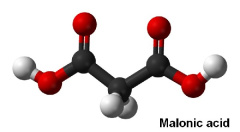Malonic acid
Synonimes:Malonic acid, MA
CAS: 141-82-2

PROPERTIES
Malonic acid (MA) is a white, crystalline substance, readily soluble in water, alcohol and ether, stable under ordinary conditions of use and storage and easily decomposed by heat. The solution in water is medium-strong acidic. Malonic acid is not compatible with oxidizing agents, reducing agents, bases. It is non-hazardous for air, sea and road freight.
APPLICATIONS
PHARMA
Malonic acid and its esters are characterized by the large number of condensation products. They are important intermediates in syntheses of vitamins B1 and B6, barbiturates, non-steroidal anti-inflammatory agents (NSAIDs), other numerous pharmaceuticals.
Synthesis of barbiturates
Malonic acid condenses with urea to barbituric acid. The methylene groups in 1,3-dicarboxylic acid utilize the synthesis of barbiturates.
COSMETICS
MA is classified as a buffering agent. Its main function is to stabilise the pH of cosmetics (e.g. in hair care products, toothpastes).
PAINTS
Paint binders can be crosslinked through transesterification. The ester of malonic acid is reacted in a Knoevenagel reaction with a carbonyl compound, preferably with formaldehyde. The reaction products are polymerized to provide a polymer having a molecular weight of between about 300 and 6000. The crosslinking components prepared provide an unsaponifiable base structure and permit the preparation of products with high functionality. That components are preferably utilized in binder systems for cathodically depositable paints.
Knoevenagel condensations
Malonic acid is used instead of the less expensive malonates for the introduction of a -CH2-COOH group under mild conditions by Knoevenagel condensation and subsequent decarboxylation.
FOOD, COSMETICS
PERSERVATIVES
Sorbic acid is a natural, organic preservative frequently used to maintain the freshness of a variety of human foods, drugs, and cosmetic products. Sorbic acid possesses antifungal, and to a lesser extent antibacterial, properties. The first synthesis of sorbic acid was performed by Doebner. Sorbic acid was made from crotonaldehyde and malonic acid in pyridine.
FEED
Malonic acid can be used to prevent the osteoresorptive effect of dark stress in broiler chicks. It is established that resorption of bone tissue in broiler chicks caused by disturbance of photoperiodism can be prevented by adding malonic acid to feed.
Other uses:
Electrolyte additive for anodization of aluminum.
Additive in adhesive compositions.
Competitive inhibitor of succinic dehydrogenase has been used extensively in investigations of the tricarboxylic acid cycle. Some further investigations have been made into its presence in plants.
| CAS | Name of article | Recent inventory | Package unit | Request offer |
| 141-82-2 | Malonic acid | 187.00 kg | 50 kg/ műa. Hordó |
Kat-Chem Kft.
Székhely
Beckó utca 23-25.
H-1149
Budapest
Iroda
Huszt u. 24.
H-1147
Budapest
Telefon: +3612219945, +3613630194
Fax: +3613835784
E-mail: kat-chem@kat-chem.hu
